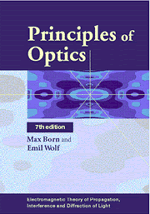Book contents
- Frontmatter
- Preface to corrected reprint of the seventh edition
- Preface to the first edition
- Preface to the second edition
- Preface to the third edition
- Preface to the fourth edition
- Preface to the fifth edition
- Preface to the sixth edition
- Preface to the seventh edition
- Contents
- Historical introduction
- I Basic properties of the electromagnetic field
- II Electromagnetic potentials and polarization
- III Foundations of geometrical optics
- IV Geometrical theory of optical imaging
- V Geometrical theory of aberrations
- VI Image-forming instruments
- VII Elements of the theory of interference and interferometers
- VIII Elements of the theory of diffraction
- IX The diffraction theory of aberrations
- X Interference and diffraction with partially coherent light
- XI Rigorous diffraction theory
- XII Diffraction of light by ultrasonic waves
- XIII Scattering from inhomogeneous media
- XIV Optics of metals
- XV Optics of crystals
- Appendices
- Author index
- Subject index
X - Interference and diffraction with partially coherent light
- Frontmatter
- Preface to corrected reprint of the seventh edition
- Preface to the first edition
- Preface to the second edition
- Preface to the third edition
- Preface to the fourth edition
- Preface to the fifth edition
- Preface to the sixth edition
- Preface to the seventh edition
- Contents
- Historical introduction
- I Basic properties of the electromagnetic field
- II Electromagnetic potentials and polarization
- III Foundations of geometrical optics
- IV Geometrical theory of optical imaging
- V Geometrical theory of aberrations
- VI Image-forming instruments
- VII Elements of the theory of interference and interferometers
- VIII Elements of the theory of diffraction
- IX The diffraction theory of aberrations
- X Interference and diffraction with partially coherent light
- XI Rigorous diffraction theory
- XII Diffraction of light by ultrasonic waves
- XIII Scattering from inhomogeneous media
- XIV Optics of metals
- XV Optics of crystals
- Appendices
- Author index
- Subject index
Summary
Introduction
So far we have been mainly concerned with monochromatic light produced by a point source. Light from a real physical source is never strictly monochromatic, since even the sharpest spectral line has a finite width. Moreover, a physical source is not a point source, but has a finite extension, consisting of very many elementary radiators (atoms). The disturbance produced by such a source may be expressed, according to Fourier's theorem, as the sum of strictly monochromatic and therefore infinitely long wave trains. The elementary monochromatic theory is essentially concerned with a single component of this Fourier representation.
In a monochromatic wave field the amplitude of the vibrations at any point P is constant, while the phase varies linearly with time. This is no longer the case in a wave field produced by a real source: the amplitude and phase undergo irregular fluctuations, the rapidity of which depends essentially on the effective width Δv of the spectrum. The complex amplitude remains substantially constant only during a time interval Δt which is small compared to the reciprocal of the effective spectral width Δv; in such a time interval the change of the relative phase of any two Fourier components is much less than 2π and the addition of such components represents a disturbance which in this time interval behaves like a monochromatic wave with the mean frequency; however, this is not true for a longer time interval. The characteristic time Δt = 1/Δv is of the order of the coherence time introduced in §7.5.8.
Information
- Type
- Chapter
- Information
- Principles of OpticsElectromagnetic Theory of Propagation, Interference and Diffraction of Light, pp. 554 - 632Publisher: Cambridge University PressPrint publication year: 1999
Accessibility standard: Unknown
Why this information is here
This section outlines the accessibility features of this content - including support for screen readers, full keyboard navigation and high-contrast display options. This may not be relevant for you.Accessibility Information
- 8
- Cited by
